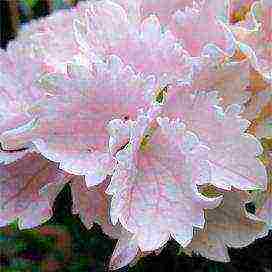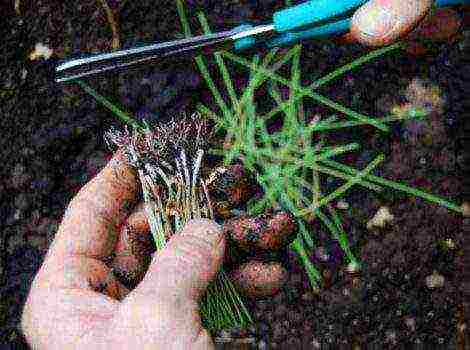Content [show]
author Arkatov I.S., photo by the author and Tim Bebel
Hydrangeas of different types are becoming more and more accessible to Russian plant lovers every year. In the species assortment of hydrangeas, large-leaved hydrangea attracts special attention of gardeners. It is presented on the modern market with many new varieties with a variety of inflorescence colors.
In recent years, there has been an abundance of materials on growing large-leaved hydrangea, but gardeners continue to ask me many questions about planting hydrangea seedlings and caring for the plant. Therefore, in this separate article, I want to draw the attention of readers of the Gardenia website. ru on the main points of agricultural technology of hydrangeas.
Planting seedlings of large-leaved hydrangea
Large-leaved hydrangeas should be planted in such a place in the garden that their bushes are illuminated by the sun only in the morning and in the evening (at least 6 hours a day).
In the direct midday sun, the leaves and inflorescences of the large-leaved hydrangea droop. With a drop in temperature in the evening and with sufficient soil moisture, the foliage of hydrangeas usually restores turgor, but the flowers may no longer recover ...
When planting a potted hydrangea in the garden, you need to do the following.
1. It is desirable that the young roots of the hydrangea seedling germinate as quickly as possible in the garden soil. Therefore, it is necessary to fill the planting hole with a nutritious and loose organic mixture composed of peat, humus, coniferous litter and garden soil. Before planting a seedling, you must decide in advance what color of inflorescences you want to have in the planted hydrangea. Later, after planting the seedlings, it can be difficult to change the acidity of the soil under the hydrangea.
To obtain pink and red inflorescences in a large-leaved hydrangea: the PH of the earthen mixture should be about 6.0-6.2 (if more than 6.4, the hydrangea may begin chlorosis due to a lack of iron in an accessible form).
To obtain blue, blue and purple inflorescences in large-leaved hydrangea: the PH of the earthy mixture should be about 5.2-5.5. Aluminum sulfate should be added to the soil. Water the plants with soft water with a pH not higher than 5.6.
It must be remembered that red and pink large-leaved hydrangeas in acidic soil, respectively, will have dark pink and pink-lilac flowers; they may not achieve the pure red and pure pink color of their varieties.
In the photo: red hydrangea "Red Sensation" in the garden; pink hydrangea "Early Sensation"
Hot weather also does not favor the development of red color in hydrangea inflorescences. Large-leaved hydrangea with white flowers does not change the color of the inflorescences (its flowers can turn pink only in autumn).
2. If your garden has clay soil, then in order to avoid stagnation of water near the roots of the hydrangea, make drainage at the bottom of the planting pit.
3. Before planting the hydrangea, very carefully, without injuring the young roots, straighten as many roots as possible from the seedling, curled around a clod of earth (after soaking it in a bucket of water).
4. When planting hydrangeas, carefully remove the old soil (as much as possible) from the top of the seedling pot to the young roots, replacing it with a prepared earthy mixture.
Watering a large-leaved hydrangea
When watering a garden hydrangea, it must be remembered that it is a very moisture-loving plant.
It is necessary to constantly keep the soil under the hydrangea and around the bush moist. This is facilitated by mulching the earth (with coniferous litter or bark).
It is necessary to spill the soil so that not only the soil around the hydrangea is moist, but also the clod of earth in which the hydrangea grew in a pot is saturated with water - where, after planting, its main root system is still located. Otherwise, this clod of earth (its composition differs from the planting mixture you have prepared) will remain dry in the planting pit!
Whenever possible, use drip irrigation to care for your hydrangeas in your garden.
Pruning large-leaved hydrangea
For the first three years, the newly planted hydrangea is not pruned, except for pruning dried branches. Do not expect a lush flowering from a young plant until the bush takes root well.
Three years after planting the seedlings, ordinary (not remontant) large-leaved hydrangeas are pruned in Russia in the spring (unlike the Tim Bebel method). At the same time, the old hydrangea inflorescences left for the winter are cut off to the first living bud. Do sanitary pruning of dried branches.
If, in the spring, you cut the last year's branch from the remontant hydrangea, depriving it of the upper (apical) bud, then a little later, several peduncles are formed from the lateral buds on the same branch in the current season.
This way you can increase the number of inflorescences only in the remontant hydrangea. The same operation with ordinary hydrangea will bring the same result only next year.
Thus, you can determine which hydrangea is growing in your garden - repair or not. Indeed, among the old varieties of large-leaved hydrangeas with lost names, there are remontant ones.
Change in color of inflorescences in large-leaved hydrangea
Large-leaved hydrangeas with pink and red inflorescences can change the original color of their flowers to blue, blue and purple. Although there are varieties of hydrangeas with pink flowers that do not stain blue well.
To change the color of the inflorescences of large-leaved hydrangea, the soil under the seedling must be acidic.
Water the plant with a solution of aluminum sulfate (1 tablespoon per 1 liter of water) every week throughout the season.
Such hydrangeas are fed with fertilizers with a low phosphorus content (N: P: K = 25: 5: 30), because Excess phosphorus binds aluminum in the soil, preventing the color of large-leaved hydrangea from changing to blue or purple.
In order for hydrangeas to remain with their original pink or red color of flowers: it is necessary that the pH of the soil is 6.0-6.2. If necessary, alkalize the soil with dolomite flour or ash.
It is necessary to use fertilizers with a high phosphorus content (N: P: K = 10: 40: 10).
In the photo: hydrangea of the Stargazer variety with different colors of inflorescences
The intensity of inflorescence coloration in large-leaved hydrangeas is associated with the presence of different amounts of dolphinidin pigment in different varieties.
When the color of the inflorescences changes, - during the transition from pink to blue, - the hydrangea inflorescences undergo a stage of lilac color.
All about hydrangea on the site
 Why don't flower shops sell hydrangea bouquets? It's just that they are probably so beautiful that it is a pity to cut them off. For garden owners in recent years, there has been no shrub more desirable than hydrangea. These are amazing bushes, immersed in white, bright pink or blue clouds of inflorescences. And the most attractive, the most delicate, the most refined of them is the large-leaved hydrangea.
Why don't flower shops sell hydrangea bouquets? It's just that they are probably so beautiful that it is a pity to cut them off. For garden owners in recent years, there has been no shrub more desirable than hydrangea. These are amazing bushes, immersed in white, bright pink or blue clouds of inflorescences. And the most attractive, the most delicate, the most refined of them is the large-leaved hydrangea.
What is it like
Large-leaved hydrangea (Hydrángea macrophýlla) is a shrub from the hydrangea family, the height of which is 1-2 m (indoor forms grow up to 60 cm). Slightly pointed oval leaves are dark green in color. Bright inflorescences of pink, blue, greenish or variegated color in shape can be varied. Bloom from June to October.
A heat-loving shrub with huge flower heads came to Europe from Japan in the 18th century. Until recently, large-leaved hydrangea in our area was presented only as a houseplant. But with the development of agricultural technology, it increasingly began to appear in the open field. True, it requires a serious winter shelter. The flowering buds of the garden hydrangea are at the tops of last year's shoots. Therefore, it is very important to preserve the branches completely so that they do not die from frost. Not so long ago, remontant varieties were bred by Dutch breeders. Such hydrangeas begin to bloom on the tops of last year's branches, and continue to bloom on the shoots of the current year. Thanks to this, they will be able to please us with bright colors even after a little freezing.
Large-leaved hydrangea varieties
- Blue Heaven (variety series Forever & Ever) - shrub 0.9-1.2 m high, crown 60-90 cm in diameter.It blooms from July to early September. Spherical inflorescences up to 30 cm in diameter. The color of the flowers can be pink, lilac or blue (the acidity of the soil affects).
- Amethyst (variety series Magical) - bush height 1-1.2 m, crown with a diameter of 80-100 cm. Chameleon: flowers in the inflorescence are greenish at first, but then change color. Good for cutting.
- Blushing Bride (variety series Endless Summer) - the height and width of the bush is about 1.5 m.It blooms from June to October. The buds of this variety bloom into semi-double sterile white flowers that gradually turn pink. Because of this peculiarity, this variety is jokingly called "The Blushed Bride". Smooth and strong twigs make this plant suitable for cutting.
Mention should be made of the "magical properties" of large-leaved hydrangea - the ability to change color depending on the composition of the soil. With a slightly alkaline reaction of the soil, they turn pink; in an acidic environment, their color changes to blue or blue.
We settle as a guest
If you decide to plant a large-leaved hydrangea on your site, then it should be noted that planting and caring for this plant has some peculiarities. We'll look at them.
Spring is a good time to plant hydrangeas, but you can also plant them in autumn until mid-September.
First, choose a place. The best for a large-leaved hydrangea would be an area with light partial shade and protected from the wind. It is desirable that the sun hits the bush in the morning and evening hours (but not less than 6 hours).
Now a few words about the "neighbors". Do not plant a moisture-loving hydrangea under trees that strongly absorb moisture. Also, its root system does not like damage, so perennials that do not need frequent transplants should be placed nearby.
When the site is selected, you need to prepare the planting pit. Its size should be suitable for a particular plant. Since the seedling will soon turn into a large beautiful bush, the hole should be prepared at least 50 × 50 cm in size and about 50 cm deep.Fill it with a loose soil mixture consisting of light earth, high peat, fallen needles and humus (2: 2: 1: 1). If the soil on the site is clay, then in order to avoid stagnant water, drainage must be put on the bottom of the pit. A very important point - hydrangeas should grow in acidic soil, alkalization of the soil is destructive for them.
It is advisable to soak the roots in a bucket of water before planting. Then carefully remove most of the old soil and straighten the roots. Place the seedling in the hole and sprinkle the roots with the prepared soil mixture. It is advisable to deepen the root collar a little (but not completely), there are the lower buds that will give young shoots.
After planting, it is necessary to thoroughly water the seedling. It is important that the soil around the plant is well saturated with moisture. Then the ground under the bushes must be mulched with peat, and sawdust and fallen needles must be poured over the mulch. This will help maintain soil moisture and maintain an acidic reaction.
We multiply
Large-leaved hydrangea can be propagated by dividing the bush, seeds, layering and cuttings. Let's consider two of the simplest ways.
The easiest and safest way to do this is by dividing the bush. To do this, we prepare holes for planting, then we dig out a bush and divide it into parts, so that each of them will have growth buds that give young shoots. Cut the roots a little before planting, and shorten the shoots to 3-5 buds. Next, we plant each part as a new bush. If we divide the bush in the spring, then in the fall the new hydrangea bushes will already take root.
It is relatively easy to do this by layering in May. To do this, you need to bend young, flexible branches from the mother plant and secure with a wire clip in a hole, the depth of which is about 15 cm.At the point of contact with the ground, it is advisable to break off the leaves, then make an oblique incision 2-3 cm long on the lower side of the branch, inserting into it a match or a sliver. Instead of making such an incision, you can simply scrape off the bark slightly. The fact is that tissue damage stimulates the formation of roots in this place. Then sprinkle with earth mixture (as for the usual planting of hydrangeas). Tie the tops of the shoots above the ground to a peg in an upright position. We water the cuttings abundantly and in the future we carefully monitor that the ground is always moist. Roots should appear by autumn. Now the new plant needs to be cut off from the mother. But it will be possible to plant it only in the spring. Hydrangea flowers can please us next year.
We take care and care
Any hydrangea needs regular watering, it's not for nothing that its name is translated from ancient Greek as "a vessel with water." The soil under the bush should always be moist. For this, it is advisable to constantly maintain a layer of mulch around the bush. Abundant watering in the fall is especially important, this will help the hydrangea to winter safely.
Hydrangeas, like any other plant, require feeding for good growth and development. It is imperative to apply fertilizers in the spring during the leafing season, before budding and in early autumn before the end of flowering. Feeding is also carried out for planting a new plant. In order to avoid unpleasant surprises, it is better to use complex mineral fertilizers intended for the care of hydrangeas. You can also use humus and liquid manure in small quantities. Do not fertilize hydrangea with ash, this can lead to alkalization of the soil.
To form the crown of a large-leaved hydrangea, like any other shrub, pruning is necessary. But pruning this plant has its own specific characteristics. Since the flower-bearing buds are located at the top of the one-year shoot, it is possible to remove all flower stalks with the wrong actions.
The main subtleties of pruning The first year
Immediately after spring planting, the growths must be shortened by one or two strong buds and the weak shoots must be cut out. Among the strong growths and side branches that have grown over the summer, only those growing inside the bush and the weakest are cut off.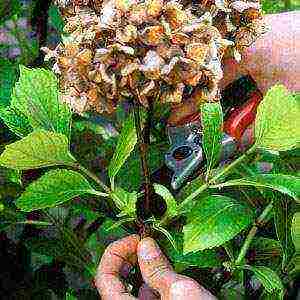
Second year
When flowering ends, strong branches grow at the bottom of the bush, which must be shortened to the lower new strong growths.
Third year and beyond
After the end of flowering, all faded branches are cut to the lower strong growths, weak ones are removed. A very dense bush must be thinned out by removing some of the old branches.
Given the peculiarity of large-leaved hydrangeas to bloom on the shoots of last year, at the end of July it is imperative to cut off the old inflorescences along with four leaves. Indeed, in August, the buds of the next year are laid, and if you are late with pruning the bush or carry it out too radically, then next year it will not bloom.
If, unfortunately, the aboveground part of the hydrangea is frozen, there is no need to despair right away. Cut off all branches shortly, then the active growth of young branches from the lower buds will begin.
We winter comfortably
Large-leaved hydrangea needs preparation for winter, because, due to the peculiarities of laying flower buds, it is not the most winter-hardy species. She must be covered before frost.
For the winter, it is necessary to cover the large-leaved hydrangea at the very beginning of November, when serious frosts are already approaching.
There are two main types of winter shelter.
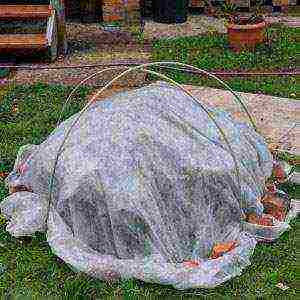 First. We carefully cover the bottom of the bush with peat (we make a good slide), lay dry leaves, sawdust, spruce branches around. Having bent the branches along the perimeter to the ground, we nail them with wire brackets. Cover the top with agrofibre and sprinkle with compost soil. To protect the shelter from precipitation, cover it with a sheet of slate or roofing material.
First. We carefully cover the bottom of the bush with peat (we make a good slide), lay dry leaves, sawdust, spruce branches around. Having bent the branches along the perimeter to the ground, we nail them with wire brackets. Cover the top with agrofibre and sprinkle with compost soil. To protect the shelter from precipitation, cover it with a sheet of slate or roofing material.
Second. If the branches are relatively tall and tough, it is important not to break them. Therefore, we tie them together, wrap them in 2-3 layers with agrofibre, install a wire mesh (frame) around the bush and fill it with needles and dry leaves inside. From above, you need to cover it with something from precipitation (roofing material, film, boards).
It is very important to open the hydrangea gradually in the spring, as one should beware of recurrent frosts.
Pests and diseases
Large-leaved hydrangea is affected by a small number of diseases and pests.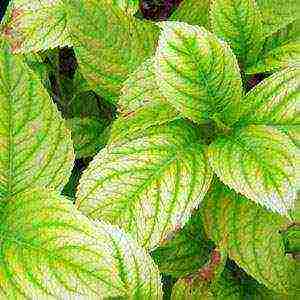
Spider mite
The leaves are striking from the underside, there you can see a cobweb. They first turn yellow and then fall off. The plant should be sprayed with acaricide.
Downy mildew
Oily spots appear on the leaves, which then increase in size and turn yellow. A yellowish bloom appears on the leaves below and on young stems. An urgent need to treat the plant with a mixture of soap, copper sulfate and water (150 g x 15 g x 10 l).
Chlorosis
With this disease, the leaves become very light, and the veins darken. This leads to alkalization of the soil, as well as too much humus in the planting pit. To cope with chlorosis, it is urgently necessary to increase the acidity of the soil in any way.
Garden decoration
Large-leaved hydrangea is so beautiful that it can decorate any garden. Huge clouds of inflorescences make it inimitable in a single location on the lawn or at the entrance. A group composition of large-leaved hydrangeas of several varieties with different shapes of flowers, inflorescences and colors will look unusual.
In general compositions, the noble severity of conifers emphasizes the lush brightness and rich flowering of hydrangea. It goes well with other ornamental shrubs - blooming one after another, they can decorate the garden all summer.
The hydrangea looks wonderful surrounded by perennial flowers and ferns. It is only important to choose the color scheme. And the hydrangea curbs and hedges look fantastic! Foam waves of various shades will not leave anyone indifferent.
It may seem that the large-leaved hydrangea is quite demanding to care for. But with some effort, you will be rewarded with a stunningly beautiful plant that will become the jewel and pride of your garden.
Many people want to have a beautiful large-leaved hydrangea in their garden. This spectacular shrub seems to be whimsical in cultivation in vain.
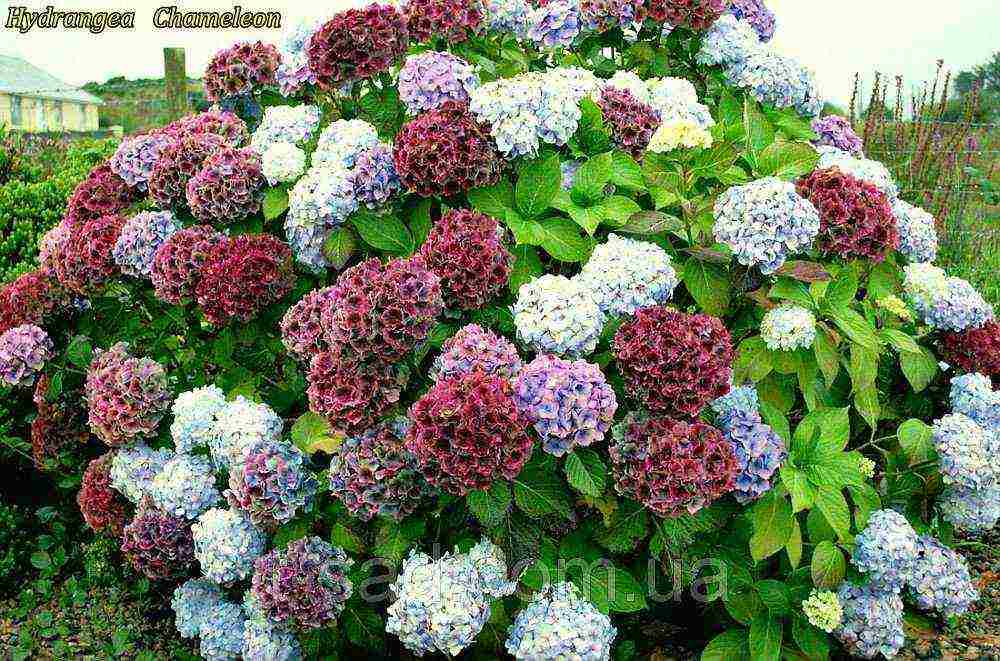
The rules for caring for broadleaf hydrangea are somewhat different from other species. By following certain agronomic techniques, you can avoid the frustration of losing your favorite plant.
What are the technologies for growing hydrangeas and how not to be mistaken with the choice of a variety?
Appearance and features
The homeland of the perennial plant is East Asia: Japan and China. Other names among professionals are hydrangea and macrophile. Hydrangea broadleaf is also called garden hydrangea.
The height of shrub forms ranges from 0.4 to 1.5 meters. Stems are erect, not fruiting. Wide large leaves, inflorescences (15-25 centimeters in diameter) of all kinds of colors - this is the appearance of a hydrangea. Bloom is observed from July to September-October.
The large-leaved beauty gives flowers on the shoots of last year, woody only in spring, this explains the freezing during wintering. Flower buds are laid in the fall and often die in the cold. Old tree stems may also not survive the cold, so it is important to carefully cover the thermophilic plant.
It grows on different soils, changing the color of flowers from white, pink, to dark red and blue. To change the color, they resort to various tricks: they are watered with special dyes, alum and vitriol, rusty nails are buried under the bush, and peat is introduced.
What varieties are available
In central Russia, mainly winter-hardy types of garden hydrangia are grown. Several dozen varieties have taken root remarkably.
Of greater interest are remontant varieties blooming both on last year's and fresh shoots. Thanks to the selection of these varieties, the large-leaved hydrangea has received a new life.
Nikko Blue
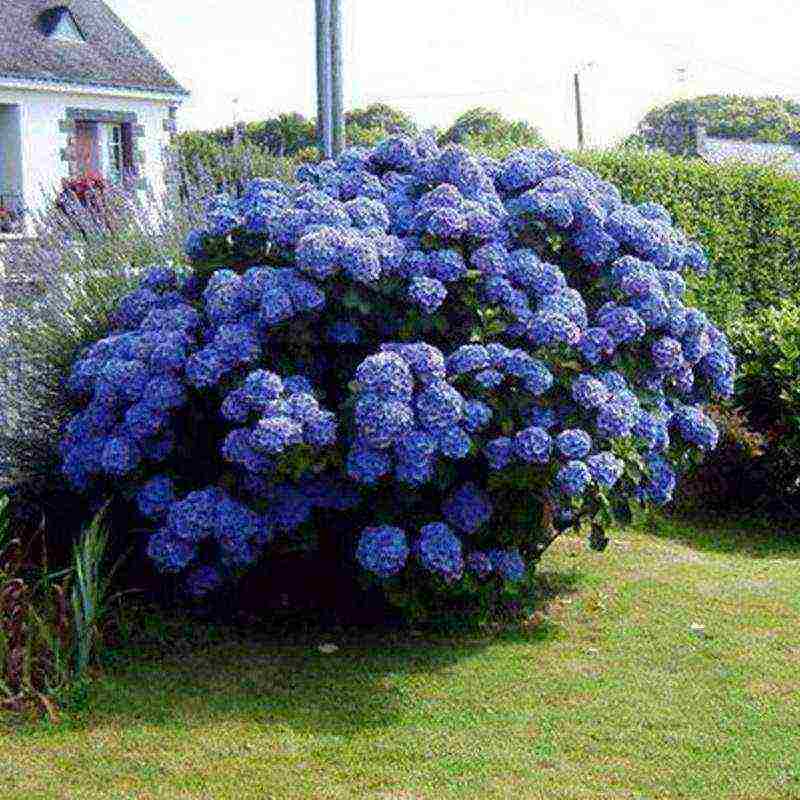
Shrub height up to 1.5 meters. The colors of this variety are different (depending on the acidity of the soil) - from white to intensely lilac. Can be grown at home. The variety originates from the broadleaf species Endless Summer. Nikko Blue develops rapidly, expanding, and releases young shoots every year.
The inflorescences are attractive, large, up to 30 centimeters in diameter. Repairability lies in the fact that the flowers bloom on the stems that have overwintered and current. The blooming ball appears to be light, weightless. The weak acidity of the soil will allow a constant blue color, and for the intensity of the color, aluminum sulfate in dissolved form should be applied under the bush.
Sweet Fantasy
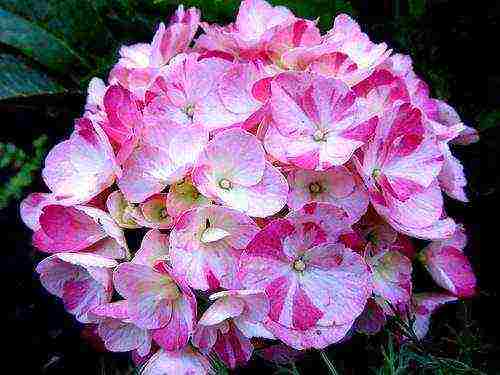
The erect bush is strewn with oval leaves and large spherical inflorescences (up to 25 centimeters in coverage). The flowers are pink interspersed with burgundy. Refers to a changeable species, the variety is capable of changing color. Blooms in July and August. Requires shelter, very thermophilic variety, does not like alkaline soils.
Tivoli
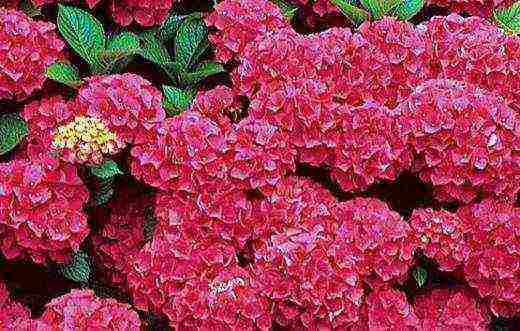
The shrub on the street grows up to 1.8 meters in height. The burgundy flower, framed by a white color, has a coverage of 20 centimeters. Loves acidic soils, changes color, under specially created conditions. Lover of partial shade and southern parts of the garden.
Variegata
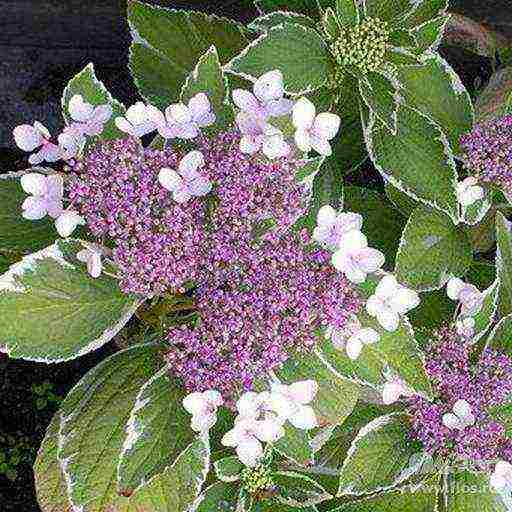
A low-growing (up to 1 meter) shrub of this variety has white flowers. The leaves are interestingly colored: green with white edging. The acidity of the soil should be reduced, does not like liming. Looks great in group compositions.
Alpengluchen
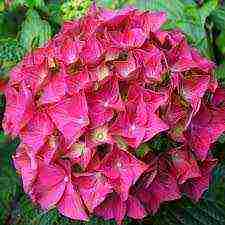
Red, dense pink color of flowers. The bush is 100-125 centimeters. Decorativeness increases on acidic soil. It blooms in early to mid-summer.
Red baron
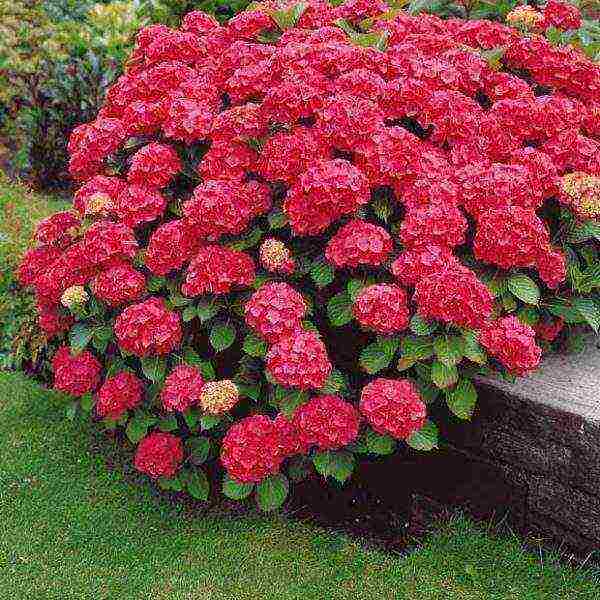
Shoots of this variety grow up to one and a half meters in height. Bright red flowers are collected in globular inflorescences. Bloom - July and August.
Bodensee
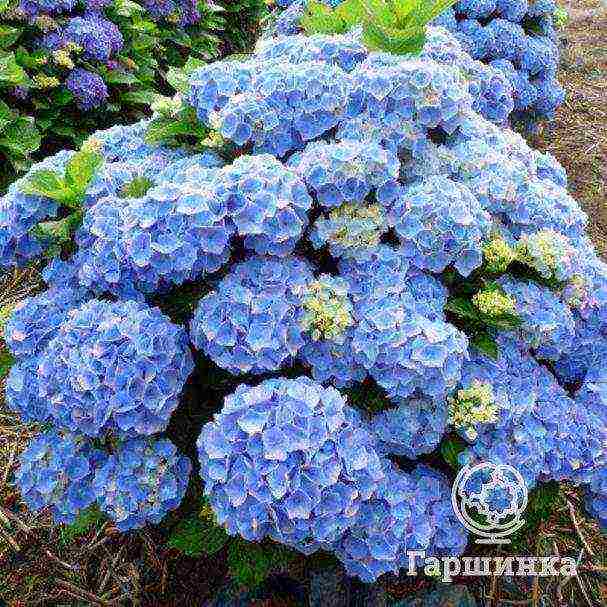
An expensive variety of large-leaved hydrangea. Inflorescences (25-30 centimeters) consist of small lace flowers in the center, becoming larger at the edge. The repair plant blooms for a long time: first on last year's shoots, then on young ones. The shrub needs support because of its height (1.5 meters) and to support the peduncles.
Endless summer
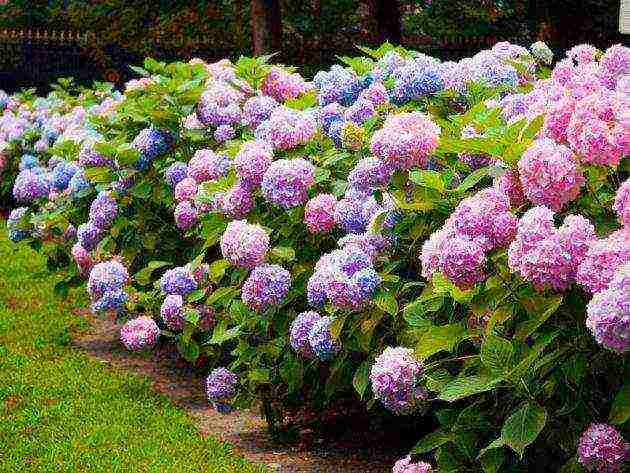
Flowers bloom on this plant, both on old, lignified shoots, and on the stems of the current year. Initially, they have a blue color, there are also white colors.
Magic Sunfields
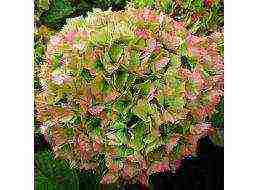
Spherical large inflorescences have an original color: red with green. The height of the shrub is 1.5 meters.
Expression

Winter-resistant, continuous flowering variety (on old and new shoots). Double flowers look like water lilies. The colors are pink, blue, purple, changing from the reaction of the soil environment. The bush is 1 meter high and about the same in coverage. At the beginning of flowering, there is a creamy yellowish color in the center, this gives the effect of two colors.
Ever Peppermint
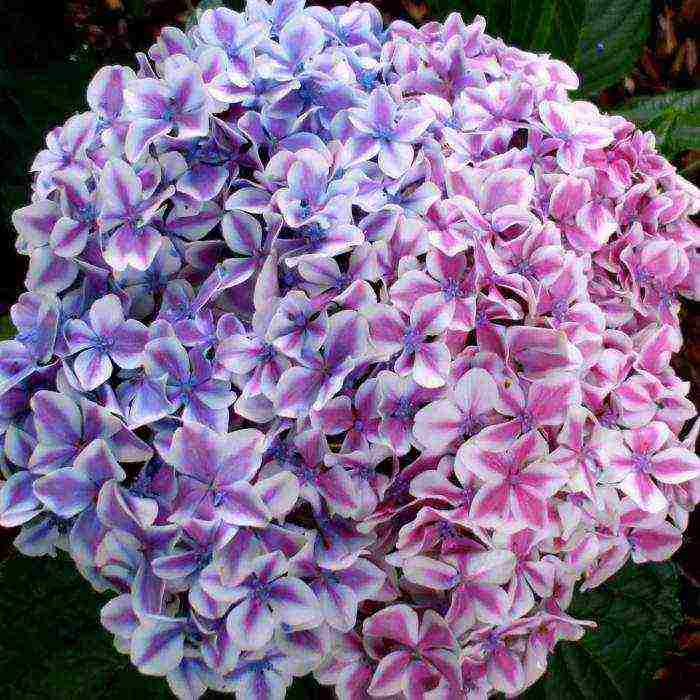
Low (up to 60 centimeters) remontant bush. Double color: white border on the edge, and inside - blue, pink or lilac color.
Red sensation

"Red sensation" is a hydrangea that blooms continuously (twice). First on last year's stem, then on a fresh shoot. Height 70-80 centimeters, the same width. The color is always red, only changing the intensity. Sun in the morning, partial shade in the afternoon: ideal conditions for this variety.
You & Me Forever
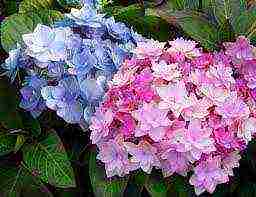
Bicolor, twice-blooming macrophile. The bush reaches 80 centimeters in height, the width exceeds this size. The color of the flowers depends on the acidity of the earth, and changes from blue to pink.
Agrotechnics of large-flowered hydrangea
This type of hydrangia is the most whimsical, it is thermophilic. Therefore, all varieties, both remontant and ordinary, require shelter for the winter. It is not difficult to grow a hydrangea shrub on your site by performing sequential activities.
Correct planting, soil preparation
The plant is planted singly or in groups. In the second case, the distance between the seedlings is at least 1 meter. Macrophila prefers acidic, drained soils. Grows well in sunny areas, with shade in the middle of the day.
Planting is carried out in early spring so that good roots appear over the summer, or in autumn. Dig a hole 30 by 30 centimeters in size (and a depth of 30 cm), add humus, sand and peat. Plant the hydrangea and water thoroughly. Finish the work by mulching the near-stem part with a mixture of peat and fertile soil.
Important! The root collar is not buried, leaving it at ground level. The roots can be trimmed a little. Annual shoots are also shortened when planting (by 3 buds).
Watering and feeding
Do not allow the plant to dry out, the formation of a crust under it. Water regularly, while feeding the bush.
In the spring, special fertilizers containing nitrogen and trace elements are applied under the hydrangea, which also contribute to the color change of the flower. Moderate acidification of the soil is carried out if a blue color is needed, and alkalization is necessary to obtain a pink tint.
In summer, fertilize with phosphorus and potassium mixtures, strengthening the plant for winter.
Pruning
Young plantings are not subjected to formative pruning for three years. They only get rid of dried branches. Their presence is determined by scraping a small area with a fingernail - the green color indicates that the stem has not died, and the brown one is dry.
Large-leaved varieties need very careful pruning. In order not to harm the buds that form in the fall, lignified stems should not be greatly shortened in the spring (spring pruning in adult bushes is carried out by reducing the ends of the shoots by 1-2 buds).
Macrophile pruning is carried out to rejuvenate, stimulate growth and shape the bush. In summer, during flowering, a third of the non-flowering stems can be removed, up to 20 centimeters above the ground (leaving the lower bud). They will bloom next year.
Shelter for the winter
- Before the onset of frost (until November), the center of the bush is covered with peat or hilled;
- Bend the branches neatly to the ground, without pruning, and the leaves must be removed so that they do not rot;
- If a break is obtained, then put a wooden box or log under the branches;
- Cover everything with spunbond or other non-woven covering material;
- Pour enough fallen leaves and light grass on top;
- Finish the "construction" with a film or roofing felt, giving stability, so as not to be blown away by snowstorms.
In the spring, the entire shelter is dismantled gradually, completely getting rid of it when the frost passes.
How to propagate
The breeding methods are as follows:
- We divide the bush. In spring or autumn, the plant is dug up, divided into parts (so that buds remain on each). Long roots can be shortened. They are seated in prepared holes.
- Rooting with bent layering. At the very beginning of May, bend a flexible twig (several), securing it in a nearby groove. Tear off the leaves, scrape off the bark and sprinkle with earth. Water during the summer, check.By the fall, a layering root system will develop, and it will be possible to cut the stem from the mother bush. The next spring, this new bush is planted.
- Propagated by cuttings. At the beginning of summer, several cuttings are cut from annual shoots, 10 centimeters long. Make a cut obliquely downward in height. Cut the upper leaves on the petiole to the middle, remove the lower ones. Stimulate the workpieces in a special solution and plant them in the ground in a greenhouse or pot. After a month, the roots will grow back, they need to be transplanted into separate pots, and for the winter they should be dug in the garden right in the pot. You can leave at home until spring.
 Hydrangea is a beautiful garden flower with fluffy multi-colored caps. They are represented by several types: by the type of shrubs up to 3 m high, small trees and vines, which can braid a tree up to 30 m in height. The hydrangea will bloom from spring to frost, delighting with its globular inflorescences. However, there are species for which this time is shorter.
Hydrangea is a beautiful garden flower with fluffy multi-colored caps. They are represented by several types: by the type of shrubs up to 3 m high, small trees and vines, which can braid a tree up to 30 m in height. The hydrangea will bloom from spring to frost, delighting with its globular inflorescences. However, there are species for which this time is shorter.
Hydrangea planting rules
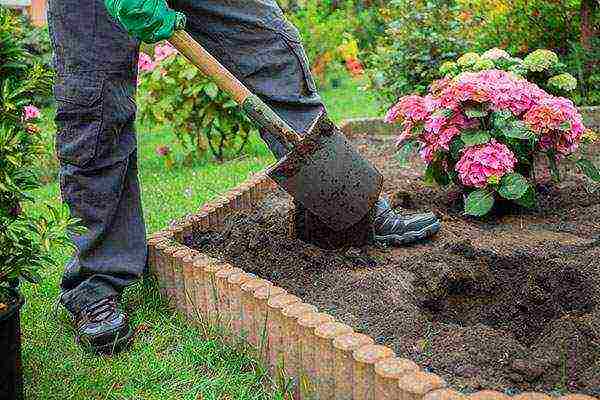 You can plant a hydrangea in early spring or fall. In this case, the first option will be preferable. For hydrangeas, you need to choose the right landing site. She prefers acidic soil with good moisture. With regard to lighting, these flowers can feel comfortable both in the sun and in partial shade.
You can plant a hydrangea in early spring or fall. In this case, the first option will be preferable. For hydrangeas, you need to choose the right landing site. She prefers acidic soil with good moisture. With regard to lighting, these flowers can feel comfortable both in the sun and in partial shade.
The whole planting process can be divided into several stages:
- It is necessary to dig a hole 40-50 cm deep and 40 cm in diameter. If the hydrangea bushes or outgrowths are small, you can make the hydrangea slightly smaller.
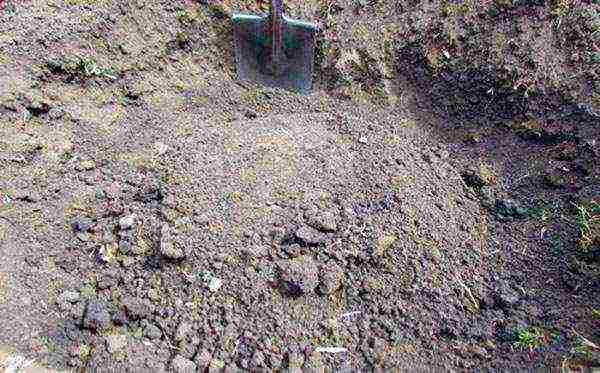
- Now you need to prepare a soil mixture consisting of fertile soil, humus and peat. It is advisable to add 50 g of mineral fertilizer to it. If possible, such a mixture is left in the pit for 15 to 30 days. If the soil at the planting site is rich and fertile, then the plant can be planted directly into it without prior preparation.
- The prepared seedling must be placed in the center of the planting pit so that its root collar is not deeply buried. Around the plant, you should carefully cover it with soil and tamp it so that the roots are well pressed and there is no void around them.
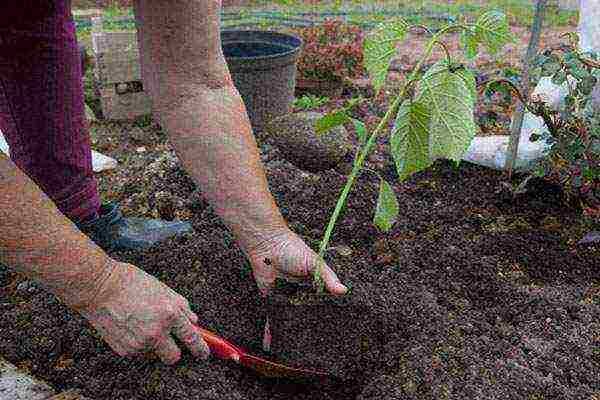
- The planted bush should be watered abundantly. It is advisable to additionally sprinkle the soil on top with sawdust, bark or peat.

After planting a hydrangea bush, it is better to cover it from sunlight for a few days. This will allow the plant to take root faster. Hydrangea can be planted both singly and in groups. In this case, the distance between the bushes should be about 1 meter.
Basic rules for caring for hydrangea
Hydrangea care comes down primarily to proper watering, timely feeding, pruning and loosening. If you do everything right, the bushes will be lush, and the inflorescences will be large and bright.
Watering
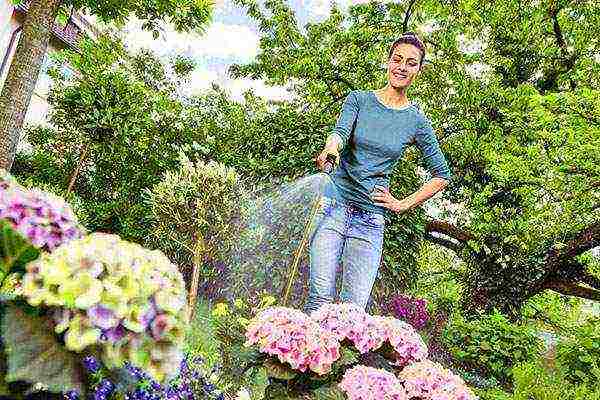 Hydrangea is a moisture-loving plant that requires frequent watering. It should be plentiful, 15 - 20 liters for each adult bush. In hot weather, this should be done once a week. In hot and dry summers, watering can be increased up to twice a week. In this case, you need to focus on the condition of the soil, given how quickly it absorbs moisture and dries out.
Hydrangea is a moisture-loving plant that requires frequent watering. It should be plentiful, 15 - 20 liters for each adult bush. In hot weather, this should be done once a week. In hot and dry summers, watering can be increased up to twice a week. In this case, you need to focus on the condition of the soil, given how quickly it absorbs moisture and dries out.
For watering, it is best to use settled soft water at room temperature. Periodically, you need to add a little potassium permanganate to it, which will prevent the appearance of rot. Water the hydrangea in the morning or evening, when it is not too hot.
Top dressing
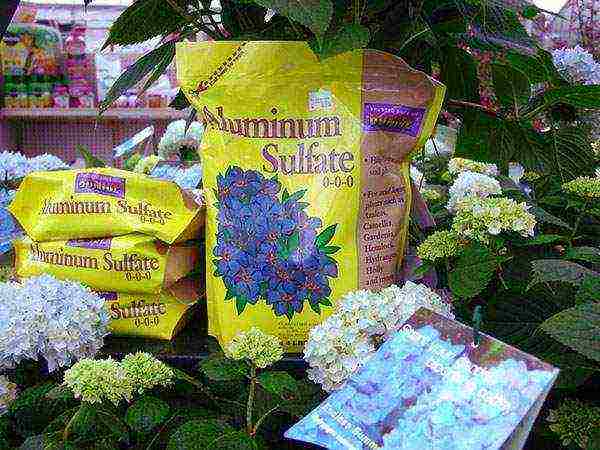 For good development and lush flowering, hydrangea needs to be fed. For this, both organic and mineral fertilizers are suitable. Their use is especially important during periods of intensive growth. You can buy ready-made fertilizers that are rich in magnesium and iron. Feeding in the form of a solution of poultry droppings with water in a ratio of 1:10 in combination with a mineral composition of 20 g of superphosphate, 10 g of nitrate and 10 g of urea has a good composition.You can use any slurry as a fertilizer, just observe the measure, otherwise the buds will be too large, which can cause fragile branches to break.
For good development and lush flowering, hydrangea needs to be fed. For this, both organic and mineral fertilizers are suitable. Their use is especially important during periods of intensive growth. You can buy ready-made fertilizers that are rich in magnesium and iron. Feeding in the form of a solution of poultry droppings with water in a ratio of 1:10 in combination with a mineral composition of 20 g of superphosphate, 10 g of nitrate and 10 g of urea has a good composition.You can use any slurry as a fertilizer, just observe the measure, otherwise the buds will be too large, which can cause fragile branches to break.
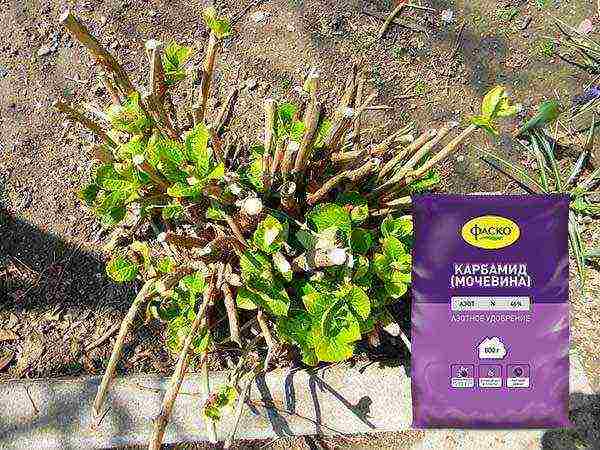 It is necessary to fertilize hydrangea not only during planting, but periodically as it grows. The first such feeding should be done at the end of May. It should be repeated after two weeks. You can fertilize flowers throughout the summer, but in August it is advisable to stop feeding so that the shoots can become woody for winter.
It is necessary to fertilize hydrangea not only during planting, but periodically as it grows. The first such feeding should be done at the end of May. It should be repeated after two weeks. You can fertilize flowers throughout the summer, but in August it is advisable to stop feeding so that the shoots can become woody for winter.
Mulching
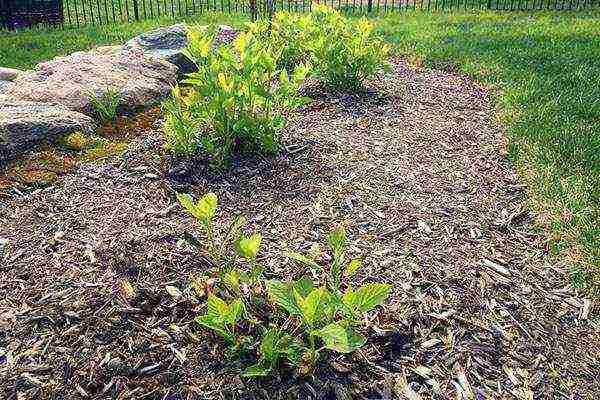 Thanks to the mulching of the trunk circle, the roots of the hydrangea will be protected from overheating and rapid growth of weeds. You must first make an organic mulch consisting of wood chips or peat. It should be scattered evenly around the bush. This will help make the soil more acidic, which is what hydrangeas need. This mulch will gradually become part of the soil.
Thanks to the mulching of the trunk circle, the roots of the hydrangea will be protected from overheating and rapid growth of weeds. You must first make an organic mulch consisting of wood chips or peat. It should be scattered evenly around the bush. This will help make the soil more acidic, which is what hydrangeas need. This mulch will gradually become part of the soil.
It is best to apply mulch under the bushes in late spring, when the soil is well warmed up. Mulching is also possible in late autumn, when temperatures are below zero. Periodically, the shrubs need to be loosened so that the soil is more moisture-permeable.
Pruning
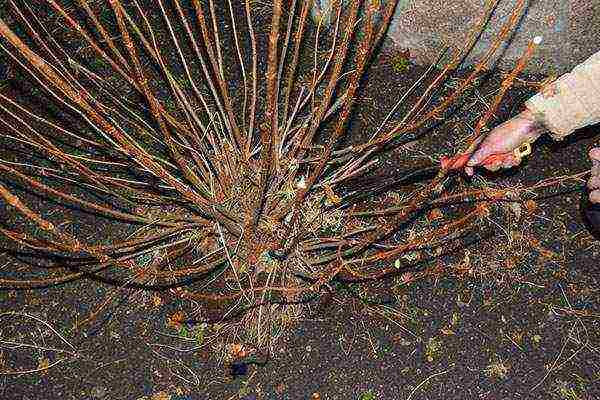 Pruning is done on plants that are 3 to 4 years old. This should be done in early spring - before sap flow and budding begin. If carried out too early, the cuttings will not be suitable for further rooting, and if it is too late, the plant may die. This is why it is important to prune when the buds are just starting to swell.
Pruning is done on plants that are 3 to 4 years old. This should be done in early spring - before sap flow and budding begin. If carried out too early, the cuttings will not be suitable for further rooting, and if it is too late, the plant may die. This is why it is important to prune when the buds are just starting to swell.
When pruning in mature plants, cut 3/4 of the height of each shoot with a pruning shear. In this case, 2 - 3 pairs of kidneys should remain on them. Old bushes can be renewed at the root. Everything will depend on the condition of the bush or tree. You need to cut off old or frozen shoots. During pruning, you can form a beautiful small tree with a certain shape. In the first year of the hydrangea's growth, its flowers should be removed. this will encourage more abundant flowering next year.
Preparing hydrangeas for winter
 Hydrangea belongs to heat-loving plants, so it must be protected in the winter season. Young shoots and insufficiently winter-hardy varieties need special protection. If the bush is very young, you can simply cover it from above with earth, fallen leaves or sawdust. Older plants must be bent to the ground and covered with roofing material or lutrasil. To prevent the wind from blowing it away, you need to press down the covering material with bricks.
Hydrangea belongs to heat-loving plants, so it must be protected in the winter season. Young shoots and insufficiently winter-hardy varieties need special protection. If the bush is very young, you can simply cover it from above with earth, fallen leaves or sawdust. Older plants must be bent to the ground and covered with roofing material or lutrasil. To prevent the wind from blowing it away, you need to press down the covering material with bricks.
Mature bushes require more cover. We must try not to break them. The bush should be tied up, and then covered with spunbond or lutrasil, after which a frame of metal mesh or other materials at hand can be built around it. It should be about 20-25 cm away from the bush. The free space must be filled with dry foliage. Such an insulated frame will protect the hydrangea well even in severe frosts. You can remove it in the spring, when there is a stable above-zero temperature.
Propagation of hydrangea
Hydrangea is propagated in several ways:
- Cuttings. Reproduction in this way is best done in mid-spring or early summer. One-year lateral shoots must be used as blanks. They should be about 10-12 cm long. Cuttings should be cut at right angles. From the bottom they need to remove the leaves.
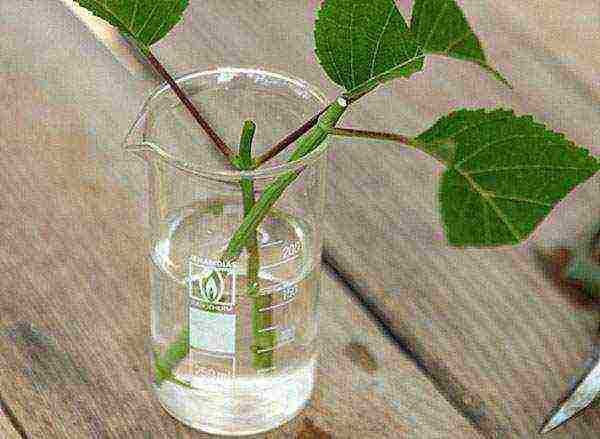 To root cuttings, you need to prepare the soil. For this, a light substrate is used, consisting of fertile soil, peat and sand.
To root cuttings, you need to prepare the soil. For this, a light substrate is used, consisting of fertile soil, peat and sand. 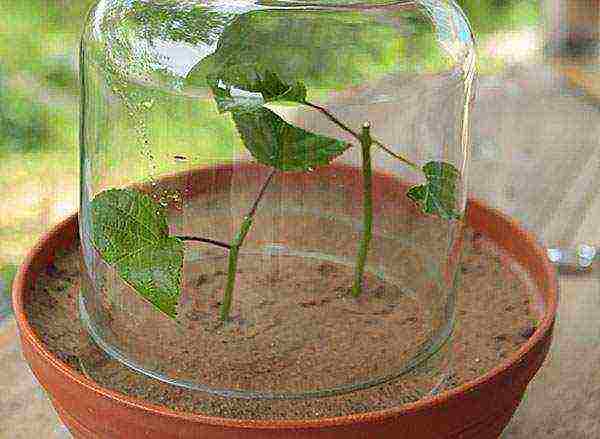 You need to plant cuttings in it, placing them at an angle. Each individual plant should be 5 cm apart. It will take about a month to root the shoots.
You need to plant cuttings in it, placing them at an angle. Each individual plant should be 5 cm apart. It will take about a month to root the shoots.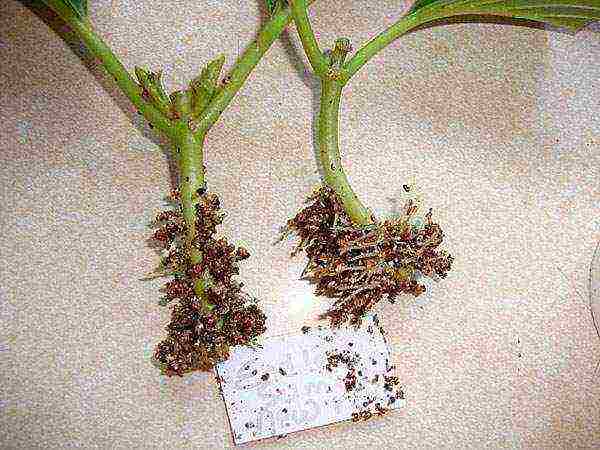
- By dividing the bush. It can be propagated both in spring and autumn. To do this, the plant must be dug up and divided into several parts so that each individual bush has a bud of renewal.After that, the plant is simply planted in the prepared places.
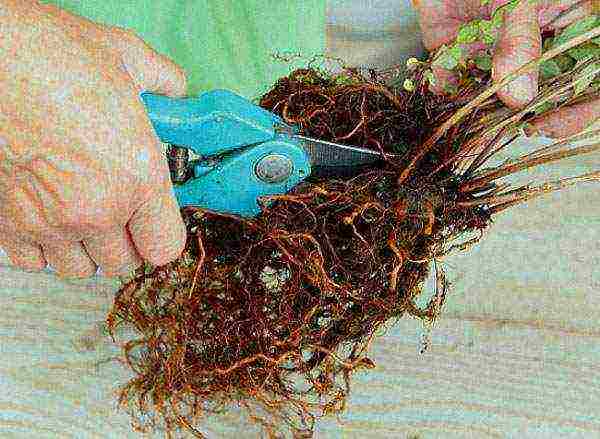
- Layers. For the propagation of hydrangea by layering, you need to select young shoots, which will not be more than a year old. They should be bent to the ground and dug in so that a small top of 20 cm remains on top. The next year, the shoot will take root and it can be separated from the main bush and planted in another place.
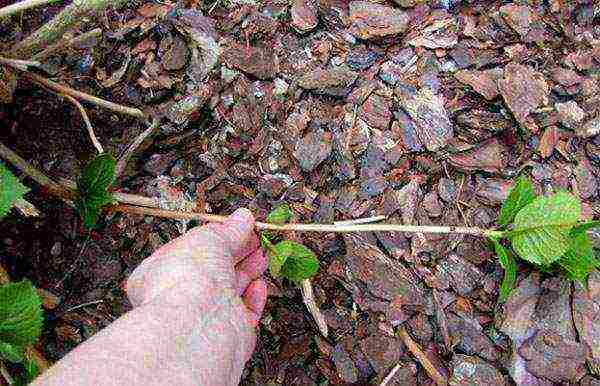
- Seeds. This is a rather troublesome process, so this breeding method is rarely used. The seeds need to be grown at home. To do this, they are planted in pots and only lightly sprinkled with sand. They need to be watered and fertilized frequently as they grow.

Popular types of hydrangea
Before planting a hydrangea, you need to decide on the choice of a suitable type. Each of them has its own growing characteristics, which must be taken into account when planting and caring for. The most popular among gardeners: Large-leaved hydrangea, Paniculata hydrangea, Stalked hydrangea, Treelike hydrangea.
Large-leaved hydrangea (Hydrangea macrophylla)
 It will delight with flowering in July-August. This hydrangea has bright, dense foliage. The shoots of the current year look herbaceous, which is why the plant has a low cold resistance. Flowers have an umbrella shape. They can have different colors depending on the variety, the intensity of which depends on the acidity of the soil. The more acidic it is, the brighter the hydrangea will be. The height of the bush reaches up to 2 m.
It will delight with flowering in July-August. This hydrangea has bright, dense foliage. The shoots of the current year look herbaceous, which is why the plant has a low cold resistance. Flowers have an umbrella shape. They can have different colors depending on the variety, the intensity of which depends on the acidity of the soil. The more acidic it is, the brighter the hydrangea will be. The height of the bush reaches up to 2 m.
Hydrangea paniculata (Hydrangea paniculata)
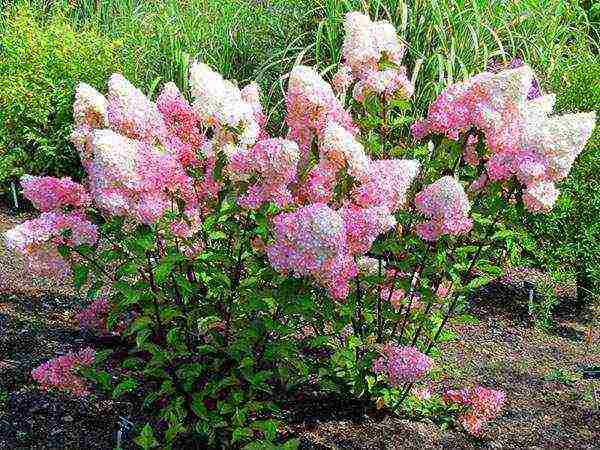 Blooms from mid-summer until the onset of cold weather. Inflorescences of this type have a pyramidal shape. They can reach a length of up to 30 cm. Panicle hydrangea grows in the form of a shrub, which can reach a height of 5 m or in the form of a small tree up to 10 m. This species is considered more frost-resistant and unpretentious.
Blooms from mid-summer until the onset of cold weather. Inflorescences of this type have a pyramidal shape. They can reach a length of up to 30 cm. Panicle hydrangea grows in the form of a shrub, which can reach a height of 5 m or in the form of a small tree up to 10 m. This species is considered more frost-resistant and unpretentious.
Stalked hydrangea (Hydrangea petiolaris)
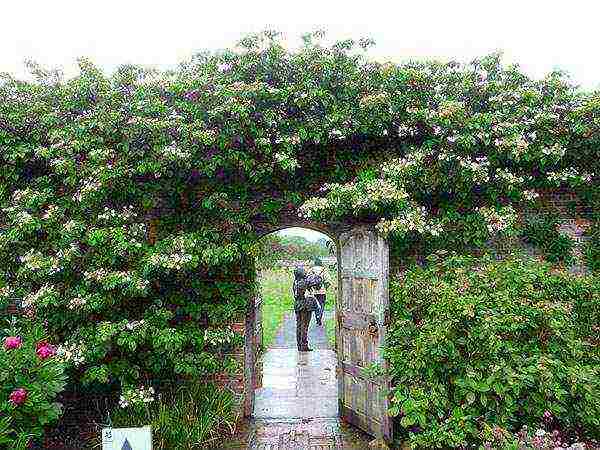 It is a shrub vine. It will require an additional support to which it will be attached with air suction cups. In length, it grows up to 25 m. This is a suitable species for planting near arches and arbors. Inflorescences have a corymbose shape up to 25 cm in size.
It is a shrub vine. It will require an additional support to which it will be attached with air suction cups. In length, it grows up to 25 m. This is a suitable species for planting near arches and arbors. Inflorescences have a corymbose shape up to 25 cm in size.
Hydrangea tree (Hydrangea arborescens)
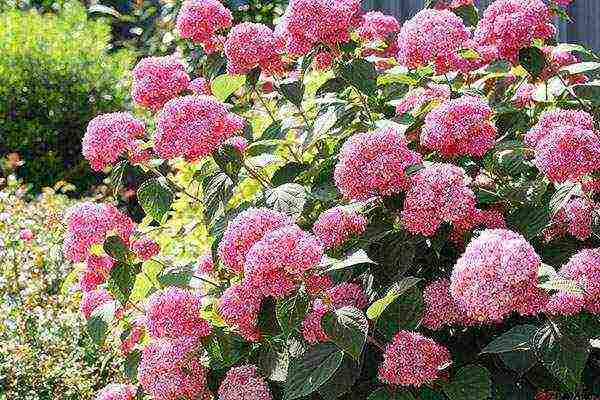 It grows up to 3 meters in height. The flowers are predominantly white or cream in color. There are several varieties of this species, differing in different colors. In winter, the plant can freeze slightly, so it must be carefully wrapped. In April, the bushes need to be heavily pruned. The flowers grow in large fluffy inflorescences.
It grows up to 3 meters in height. The flowers are predominantly white or cream in color. There are several varieties of this species, differing in different colors. In winter, the plant can freeze slightly, so it must be carefully wrapped. In April, the bushes need to be heavily pruned. The flowers grow in large fluffy inflorescences.
Ground cover hydrangea (Hydrangea heteromalla)
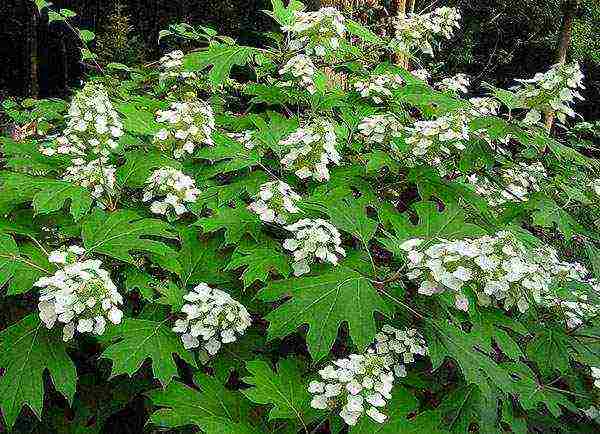 It is also called the Bretschneider hydrangea. This species is considered hardy and unpretentious. The bush reaches 2 - 3 m in height. The inflorescences are corymbose. At first they are white, and at the end of flowering they turn pink. Such a hydrangea blooms in the middle of summer.
It is also called the Bretschneider hydrangea. This species is considered hardy and unpretentious. The bush reaches 2 - 3 m in height. The inflorescences are corymbose. At first they are white, and at the end of flowering they turn pink. Such a hydrangea blooms in the middle of summer.
Recommendations for planting and caring for hydrangea in the garden - video
